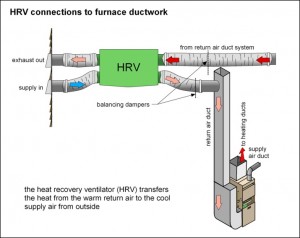State of MN doesn’t think so and has adopted a new energy code.
Most realtors and homeowners don’t realize since June 1, 2009 our housing has been subject to new residential energy requirements. If interested you can download the full Energy Code called Chapter 1322 at www.dli.state.mn.us/ccld/pdf/sbc_1322.pdf
The entire MN Energy Code is essentially about 2 principles…
 Envelope Performance
Envelope Performance
This is all about the rate of energy loss through the shell of the building. Heat loss is caused by the continuous energy load within the house which is called Base Load. This includes things such as lights, water heating, and cooking power. We can control these losses by installing more efficient appliances and devices. Outside air temperature also effects heat loss and this is called Seasonal Losses. These losses are reduced by the proper installation of quality insulation, vapor barriers, and efficient sealing.
Ventilation
Because our homes have become so tight the rate of air exchange is practically nothing. The new code requires a complete air change each hour. Half of the air in a home can be exchanged by a continuously operating mechanical system and the other half by a passive means, like opening a window. This can be accomplished with kitchen and bath exhaust fans that run continuously, but this isn’t the most efficient method. A better way are with either a heat recovery ventilator (HRV) or energy recovery (ERV), but this way is very expensive.
Without these 2 principles in balance and working together, there can be great risk to the air quality of the home.
Can you hear the whisper of stale air or mold?
Doug Hastings
MN Home Inspector, Minneapolis & St. Paul
ASHI certified inspector
Kaplan University, Home Inspection Lead Instructor
Rob ‘Pops’ Leslie
Kaplan Professionals, Retired



Great post about the energy requirements – this is new information (to me) that I was not aware of.
Question: Is there a way to tell what the air quality of my home is today? In other words, if I have a problem?
And, if I want to sell my home, and I don’t have one of the ventilation methods you mention installed, does that mean I have to install something before I can sell my home to meet the new codes?
Any help you can give would be appreciated. I enjoy reading your blog and can tell you know what you are doing in the home inspection business – thank you!
Many people are unaware of the new energy code requirements; however, codes are not retroactive so existing homes are not bound by its requirements. If a home is extensively remodeled these energy provisions would be required in the remodeled portions of the home only.
There are contractors that do test homes for air quality and this is the best method for assessing the condition of a house. Depending on your concerns you can test for environmental problems like mold, radon, lead, asbestos, etc. When selling your home in MN, you are not required to either test or improve the ventilation methods of your existing home. In other words, to sell your home you do not need to meet the new energy code. Having said that, hot topics for buyers today are radon and mold; to be proactive in a real estate transaction, you should consider testing for those two. Keep in mind; if you do test as a seller, the MN real estate disclosure law requires that the results be disclosed to the buyer.
Any questions let us know.